1945 - 1955
1945 -1955
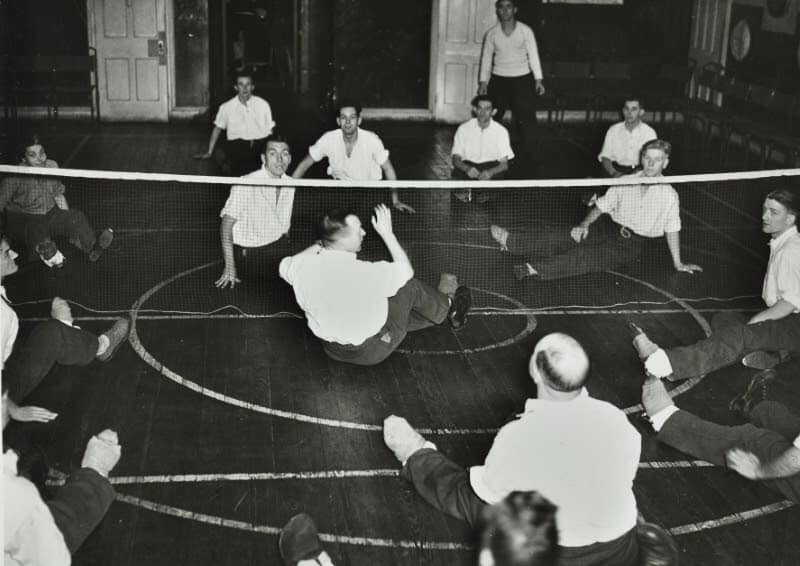 1943 was already a "ball game" played with a net. Popular in Germany and Scandinavian countries.
1943 was already a "ball game" played with a net. Popular in Germany and Scandinavian countries.
1945
In most countries there is medical care for the many war victims. Most of the care is aimed at the thousands of war veterans with all kinds of serious disabilities. Military rehabilitation centres and sanatoriums are opened. Rehabilitation and small gymnastics exercises are practiced in these centres. From these centres, departments across the country are encouraged to set up sport-based activities. Archery and table tennis are the main activity. There is no policy to encourage other sports programs. Most activities are organized in the military barracks and on the basis of therapeutic treatments.
The League of the Netherlands Military War victims was founded. The League had an important role in the development of the sport for the disabled in the Netherlands. The sport has been developed, as in many other countries in the military rehabilitation centres, by medical specialists and sports instructors. In order to coordinate sports activities, a Sports Commission was established with Wiel Teunissen as a stimulator. Anton Albers and Tammo van der Scheer (as a sport technical instructor) were also included in this committee. The aim of the committee: to stimulate sport for disabled people and to organize national sport events. The committee received a lot of support from the military Rehabilitation center Aerdenburg in Doorn.
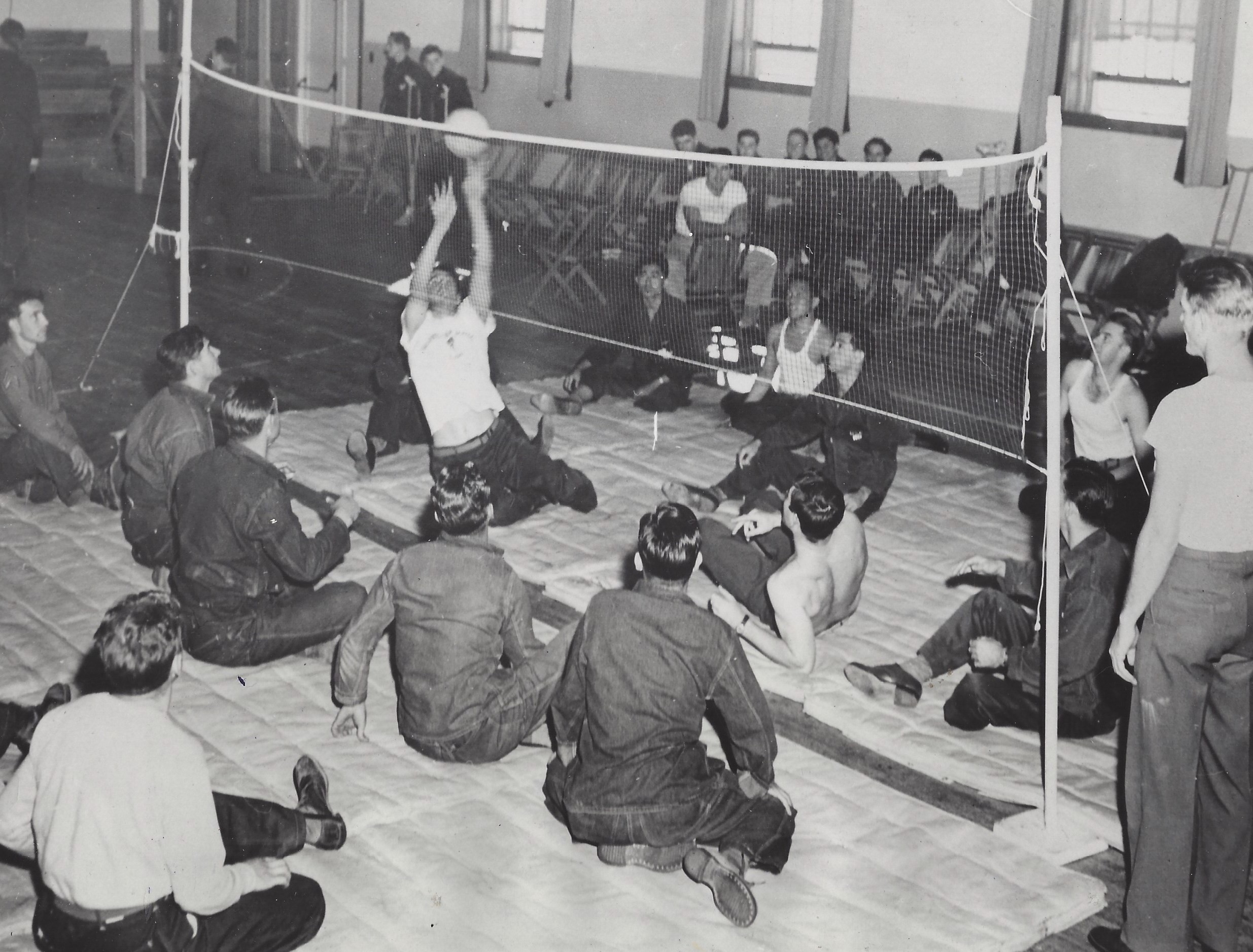 1944 A "ball" game in a rehabilitation center in the USA.
1944 A "ball" game in a rehabilitation center in the USA.
1952
The World Veterans Federation (WVF) played an important role in stimulating sport as a valuable rehabilitation technique. During the World Congress in Paris, many speakers informed international participants about the benefit of sport during the rehabilitation process.
1952
First International Sports Festival. During an important rehabilitation conference in Paris in 1952, the Dutch delegation met Dr Ludwig Guttman. Dr Guttman invited a Dutch team to participate in the 1952 Stoke Mandeville Games in Stoke Mandeville (England). This meant that Sport's International contacts opened up new objectives. In 1952 the Dutch team made the journey by boat from Rotterdam to England to participate in the Stoke Games. The first international competition became a fact. In the years that followed, the Dutch Ministry of Defense offered Dutch athletes to fly them to the annual Stoke Games in England with a Royal Air Force Dakota. In any case, that ministry was of great importance for the development of sports for the disabled in the Netherlands. Support with free accommodations, transportation, drinks and meals during tournaments etc... all activities came from personal efforts and locally the Military barracks were offered for the sports facilities. Captain Herman Tjebbes of the BNMO played an important role in the Netherlands. He established contacts with Stoke Mandeville in 1952 and, on behalf of the Netherlands, held a permanent seat on the Board of the ISMGF until 1980. After this, the Dutchman Pieter Joon was elected to the Board of the ISMGF and retained this seat until 1992.
1953
Volleyball, as a mainstream sport, is very popular at the end of World War II. The start of sports for the disabled in the Netherlands is an initiative of the Military Rehabilitation Center.
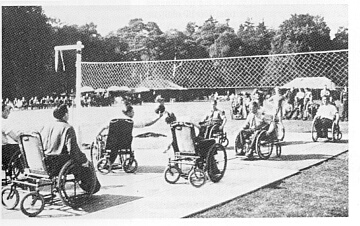 one of the activities was "wheelchair volleyball".
one of the activities was "wheelchair volleyball".
The athletes in this game were all paraplegic veterans and the games were short. A team consisted of 4 players and each set had a time limit of 15 minutes. Wheelchair volleyball had to compete with the increasing popularity of wheelchair basketball. Due to the poor construction of the wheelchair, many movements could not be made in most sports. For amputees, poor or no prosthesis also caused a lack of options. Seated gymnastics and all kinds of ball games were discussed. Ball games with their own rules for local fun while exercising.
The Military Organization (BNMO) in the Netherlands also decided to open the door to civilian war victims.
1954
Two Dutch war victims, including Mr Teunissen, received an invitation from a German sanatorium to recover in Germany. They accepted the invitation and returned with many enthusiastic new gymnastics and sports rehabilitation techniques. Special "seated" ball games were promoted.
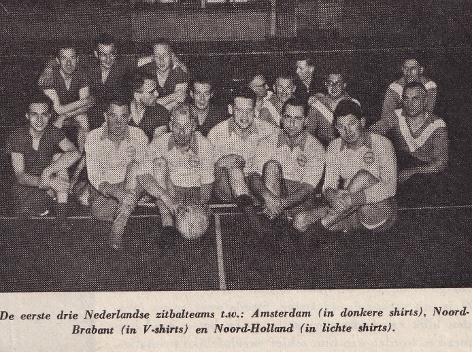
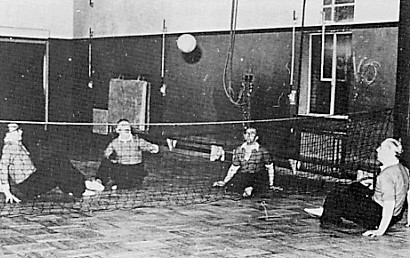 foto: the German "Sit ball" practiced in 1955 in the Netherlands with Wiel Teunissen (r)
foto: the German "Sit ball" practiced in 1955 in the Netherlands with Wiel Teunissen (r)